Costa Rica’s weather is the typical tropical climate with a rainy and dry season. However, there are many micro-climates in the country.
In this post you will learn about Costa Rica’s weather, the tropical seasons, reliable forecasts and more.
Once you know what the weather is like in Costa Rica, you know what to pack for Costa Rica so you come prepared.
This post has affiliate links which we may earn a small commission from if you choose to purchase, at no extra cost to you. Listed prices are quoted in USD and are estimates. More info: Disclosure
Costa Rica Weather: Tropical Seasons
Costa Rica is a tropical country, just 8-12 degrees above the equator. However, this doesn’t mean that it’s just hot and humid year round throughout the country.
But it does mean that the majority of the country experiences the two tropical seasons: dry and rainy.
Costa Rica’s tropical dry season is generally December to April. Rainy season is generally May to November. May, November and December are generally known as “transition” months when the season change.
There are some places in Costa Rica that do not strictly follow these two seasons, which we will talk more about below.
It is important to know that average year round temperatures in Costa Rica do not fluctuate greatly, usually only by a few degrees.
Remember that Costa Rica uses the metric system so temperatures are in Celsius.
Breakdown by Months
As Costa Rica’s climate is tropical with over 25 micro-climates, the weather isn’t always predictable or strictly what the forecast says.
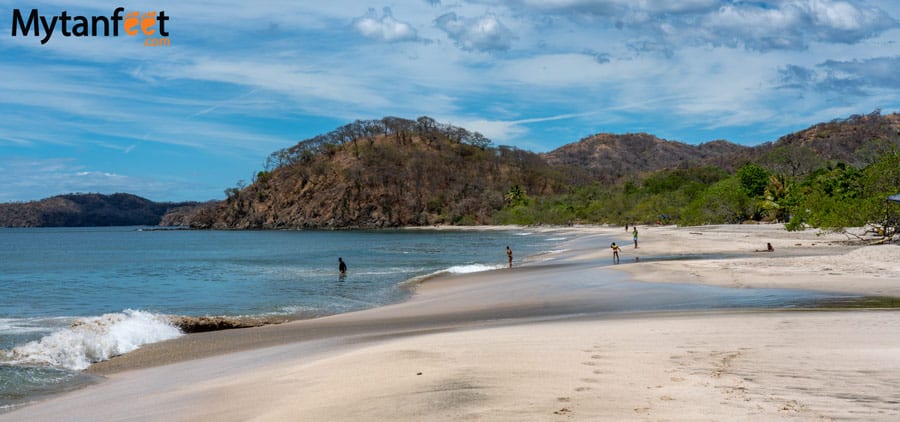
This is very important so you do not freak out when you check the weather app, because it may not accurately describe the day, especially in the rainy season when it will say it’s storming everyday.
Costa Rica Weather January
January is well in the dry season but may still have some short random on and off sprinkles in the high elevation areas, the Caribbean and the rainforest. Windy, dry and sunny on the coasts, very comfortable temperatures in the Central Valley and mountains.
Read more about what January in Costa Rica is like.
Costa Rica Weather February
February has the best weather as it’s not quite as hot as March and not as humid like in rainy season. Lots of sunny days and clear skies throughout the country. There may be the odd rains here and there in the tropical rainforests still though!
February is one of the best months to visit Costa Rica for best weather.
Read more about what February in Costa Rica is like.
Costa Rica Weather March
March is usually the driest month in Costa Rica with very high temperatures. Expect sunny and hot days. On the coasts, March is extremely dry with clear blue skies all day long on the coasts. Even the Caribbean has dry weather in March.
Temperatures in March can get up to 95-100° F (35° – 38C) on the coasts. In the Central Valley and rainforests, temperatures are around 75 – 85° F (24° – 29C). So don’t forget your sunscreen!
Something to know is that water temperatures can be cold in March. It has gone down to even 65° F (18° C) before, normally it is around 80° F (26° C). Temperatures are a consistent 85-95° F (29 to 35° C) in March on the coasts.
Read about March in Costa Rica here.
Costa Rica Weather April
April is generally the hottest month in Costa Rica. It’s at the end of dry season, so April can see some random rains throughout the country as it will begin the transition time to rainy season. Because of the first rains, it will start getting more humid.
After Holy Week, there may be some more constant rains and cloudy days in the country. The Central Valley and Central and South Pacific coasts in particular can start seeing more constant rains around mid and end of April.
Something important to note is that the beginning of April and end of March are generally the second busiest time of year as it coincides with the Northern Hemisphere spring break and Easter Week (Semana Santa) which is a major holiday in Costa Rica. Prepare for a busy and crowded visit during those times.
Costa Rica Weather May
May is the transition month from dry to rainy season. Be prepared for high humidity. Can have random hard rains here and there but generally still hot with sunny mornings.
It is hard to predict the weather as rains may be intermittent and sporadic so don’t forget your rain jacket. May is usually a quieter month in Costa Rica with fewer tourists.
On the Caribbean coast, May has possibilities to rain at any time but will still have sunny dry mornings.
Costa Rica Weather June
June is proper rainy season with cloudy dry mornings on the coasts. On and off rains in afternoons, evenings and nights. May get random downpours in the evenings.
Beginning of June is normally very quiet, by mid June, lots of families start coming down for summer vacation. Water clarity is good in June normally.
The Caribbean coast may rain a bit more in June.
Day time rainy season temperatures don’t vary too much from dry season. It gets a bit cooler at night, particularly up in the mountains.
Costa Rica Weather July
Around mid July, Costa Rica normally gets something called “little summer” or veranillo. The weather dries up and it seems like dry season with clear blue skies and beautiful sunsets. July can get big swells, great for surfing.
Also a good time for other water activities like rafting as rivers are fuller but not crazy. The Caribbean coast tends to rain more in July as well.
July is one of the best months to visit Costa Rica during the rainy season.
Costa Rica Weather August
Starts raining more consistently. Tropical waves become more frequent, so there may be some days where it rains in the morning and almost all day.
When there isn’t a tropical wave, it’s beautiful and sunny with possibilities of intermittent rain in the late afternoons.
In the Central Valley, it is very common to rain in the evenings and nights in August. For wherever you are in the country, schedule all your activities in the morning.
Generally, mornings are still dry. It usually starts getting cloudy, dark and rainy in the afternoons.
Read more about August in Costa Rica.
Costa Rica Weather September
September is a rainy month, right in the middle of the season. Expect rain wherever you are in the country so bring your rain jacket!
The North Pacific Coast may still have drier days than the rest of the country. On the Caribbean coast, it starts to dry up and start getting more dry, sunny and clear days as October is the summer month there.
There are also chances of tropical storms in September. If there is a tropical wave or storm, it can get very windy and it may rain all day or days. These are what we always look out for on the news – if they mention anything about a tropical onda or tormenta torpical.
Read more about Costa Rica in September.
Costa Rica Weather October
October is the summer month on the Caribbean coast so expect full on sunshine. For the rest of the country, October is the rainiest month.
Be prepared for rain, thunder and lightning storms. Always be prepared for rain whenever you go out and check road conditions.
October is the lowest month for tourists due to the rain, so it’s a good time to visit if you don’t mind getting wet as you’ll avoid all the crowds. However, you may run into a tropical storm or wave, which can hinder your excursions.
If you visit in October, try to stick to just one or two destinations and avoid rural areas as floods, landslides and road closures are common due to the rain storms.
You may want to avoid the South Pacific like Osa Peninsula and San Vito for these reasons.
Costa Rica Weather November
November is the transition month from rainy to dry season. Still be prepared for rain throughout the country.
November is our personal favorite month in Costa Rica. It’s lush, green and fresh all throughout the country. There aren’t many tourists yet compared to December.
November is a tricky month for water adventures like white water rafting because river levels may be too high. For safety, tour operators will not run if water levels are too high.
Additionally, November is one of the rainiest months for the Caribbean coast.
Costa Rica Weather December
In December, the transition between rainy and dry is more apparent. The “Christmas winds” start and can still rain in high elevation areas and the rainforests. But by about mid December or so, rains become much less frequent and normally occur only at night throughout the country.
It is super windy in December so be careful of any activities like parasailing, ocean kayaking, surfing and catamaran cruises. Usually by Christmas on the Guanacaste coast and Nicoya Peninsula, the rains have stopped.
The Caribbean coast is still rainy in December, as it is influenced by the cold fronts from the Northern Hemisphere.
Best Weather in Costa Rica
Many people ask us “When is the best weather in Costa Rica?” The best weather in Costa Rica is December – April due to the dry season, particularly the months of February and March.
But if you are visiting in October, you can get great weather on the Caribbean coast.
If you’re not sure when to visit Costa Rica, read our post “Best time to visit Costa Rica.”
Locations
With over 25 micro-climates, weather can vary a LOT depending on where you are going in Costa Rica.
Central Valley Weather (San Jose, Alajuela, Heredia, Cartago)
The Central Valley experiences a typical tropical climate. Average dry season temperatures are mid 70s F (24 C) during the day, cooling down to the 60s° F (18° C) at night. In rainy season, temperatures can drop all the way down to 50s° F (12-14° C) at night.
The Central Valley is known for having the most comfortable weather in Costa Rica.
Guanacaste Weather (Liberia, La Cruz, Tamarindo, Samara, Nosara, Gulf of Papagayo)
Hottest and driest months are March and April, temperatures can reach 100° F (38° C). Rainiest months are September and October. Gets very humid in rainy season. The Guanacaste province, especially the North Pacific, tends to have a longer dry season.
Nicoya Peninsula Weather
The Nicoya Peninsula like Santa Teresa and Montezuma experiences the same weather patterns as the Guanacaste coast.
La Fortuna Weather
Temperatures in dry season during the day are around low to mid 80s° F (27° C) and low to mid 70s° F at night (23° C). About the same in rainy season.
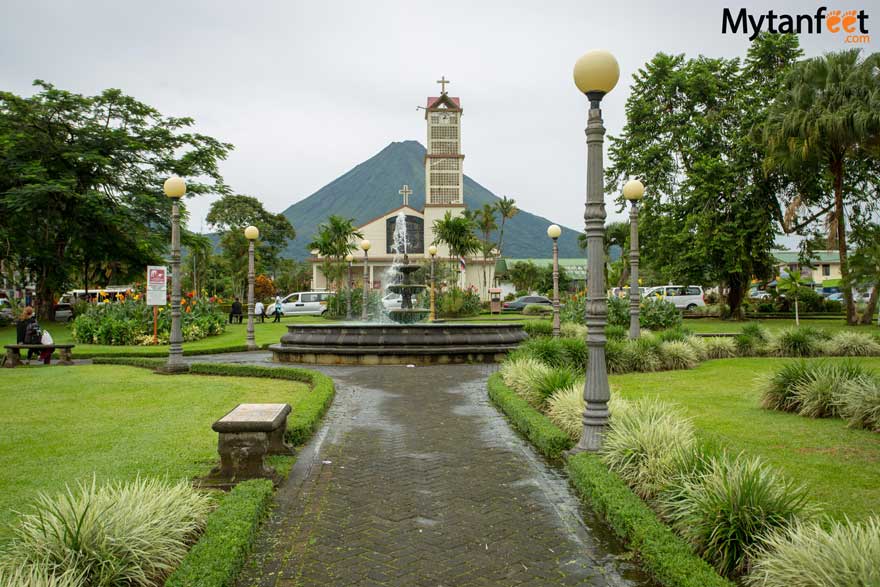
Rainiest months are May, June, September and October. Hottest months are March and April. Can rain sporadically in March or April.
Carribbean Weather (Tortuguero and Puerto Viejo)
Experiences different weather than the rest of Costa Ric so it does have the possibility to rain throughout the year. Doesn’t have a clear distinction between dry and rainy season.
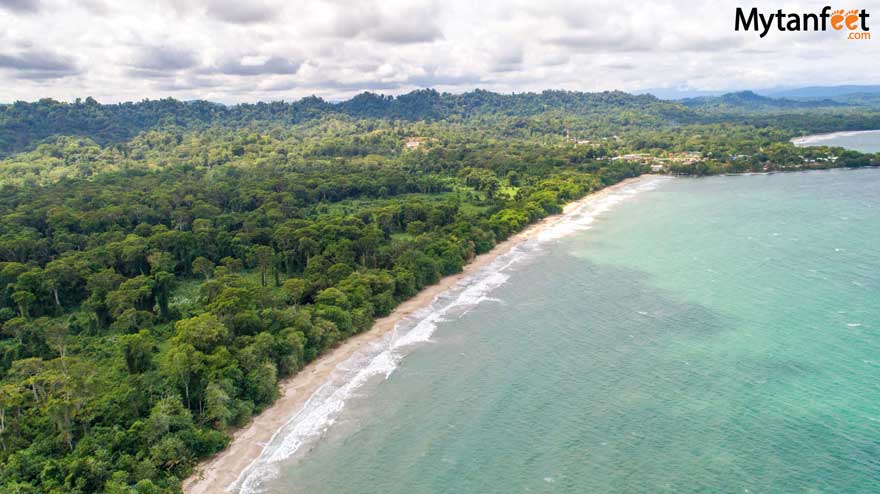
Drier months are February, March, September and October. Rainier months are November – January, April – August.
Temperatures are usually in mid 80s° F (27° C) and cool down to mid 70s° F (25° C) at night. It’s always humid on the Caribbean coast.
Jaco and Manuel Antonio Weather
Experiences typical tropical weather and is very humid all year long.
Day temperatures reach around mid 80s° F (27° C) and cool off to mid 70s° F (25° C) at night. Temperatures stay about the same as dry season. Rainiest months are September – November. Generally is still sunny in the mornings but starts raining mid afternoon or so.
Costa Ballena Weather (Dominical, Uvita, Ojochal)
Similar weather, seasons and temperatures to Manuel Antonio (hot, humid). It has more rainforest so can rain sporadically in the dry season and can have very intense rains during rainy season.
Osa Peninsula Weather (Drake Bay, Puerto Jimenez, Corcovado National Park)
Dry season temperatures are similar to the Caribbean and Jaco/Manuel Antonio. The Osa Peninsula is generally around mid to high 80s° F (27-32° C) during dry season.
This area can rain a lot and it rains hard! Especially June and September – November. During those months it can start raining early afternoon through the night.
It is always very humid in the Osa Peninsula.
Monteverde Weather
Monteverde sits around 1500 meters (4900 feet) in elevation so weather is fresh mountain weather. However this area does tend to rain more being high in elevation.
Dry season temperatures average around high 70s° F (26° C) and cools off at night down to mid 60s° F (18° C). Can have light showers and sprinkles during dry season which is why you will see lots of rainbows in Monteverde. Driest months are March and April.
Fairly rainy in May, June, August – November. Can still have sunny and dry mornings but will start raining by noon or mid morning in the rainy season.
Rainy season day temperatures are around low 70s° F (20° C) and high 50s° F (10° C) at night.
Monteverde’s weather is also similar to San Isidro del General, Bajos del Toro, Vara Blanca and San Gerardo de Dota (a bit colder) as they are all high in elevation.
Costa Rica Weather Things to Know
- It doesn’t snow in Costa Rica
- There are no four distinct winter, spring, summer and fall seasons
- The sun sets and rises around the same time all year long. Sunrise is generally 530 AM, sunset is generally 530 PM.
- Costa Rica does not participate in daylight savings time.
Average Temperatures in Costa Rica
Generally, the average temperature in Costa Rica does not vary greatly. For example, temperatures in November don’t differ too greatly from February despite it being in rainy and dry season. The average temperature in Costa Rica is between 72° to 82° F (22° to 28°C).
For most of the country, the hottest months in Costa Rica are March and April. January and February are also very hot and may only differ by a one or two degrees (Celsius).
The rainiest months are generally September and October (except for the Caribbean) so you will find that this depends on the region.
Dry Season
Dry season is generally from beginning of December to end of April in Costa Rica. Day time temperatures are around low to high 90s° F (35° C) on the coasts. Average daytime temperature in the Central Valley are around low to mid 80s° F (29° C).
Winds get very strong and there can be big swells on the Pacific and Caribbean coasts during December, January and February.
The Pacific coast gets extremely dry. It turns yellow like a desert, rivers and waterfalls dry up and it gets really dusty. This is in Guanacaste and the Nicoya Peninsula.
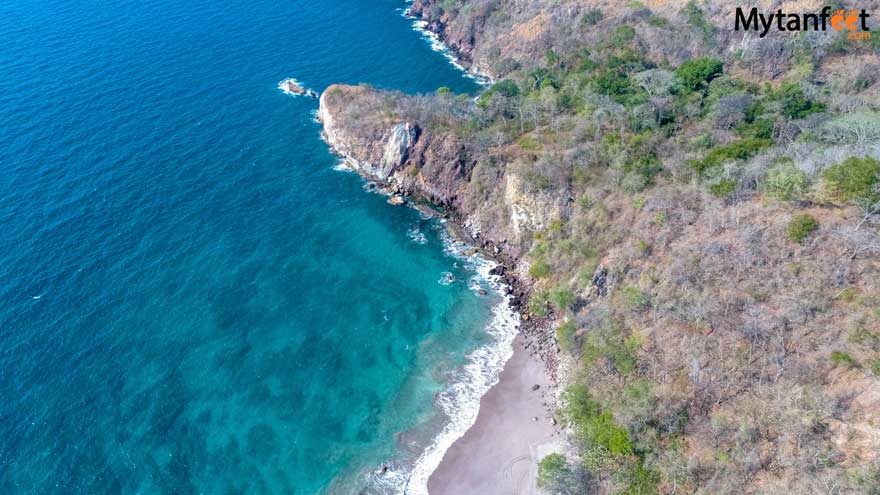
Dry season also correlates to the high tourism season thanks to the snowbirds and vacationers who want to get away from the intense winters up north. End of December through April is very busy.
How to prepare for dry season
Wear lots of sunscreen, at least SPF 30-50. Make sure to re-apply frequently and do not forget chapstick with SPF or after sun gel.
Bring an insulated water bottle so you can always have cold water.
Shorts, tank tops and flip flops will be your outfit for most of the country. We recommend clothes that dry fast like Nike dri-fit. You’ll be very sweaty!
What to know about dry season:
It can still rain in some parts of the country like the South Pacific or Osa Peninsula as those areas are more humid. We visited Dominical in February and it poured for 5 days straight.
There are still mosquitoes in Costa Rica during dry season. Bring repellent.
The Caribbean does not have a distinct dry season. There is a dedicated section to the Caribbean weather in Costa Rica below. Read it if you’re visiting Tortuguero, Limon or Puerto Viejo de Talamanca.
The dry season doesn’t just all of a sudden start as if someone turned off a faucet of rainy season. It will gradually stop raining less and less in December. That is why we call November, December, May and June our transition months.
Dry season is what locals call their summer.
Rainy Season
Rainy season is generally from beginning of May to mid December.
Normal rainy season days are sunny in the mornings and rainy in the afternoon and evenings. It is even more humid than dry season. It’s common to see the weather say “current temperature is 32° C but feels like 38° C due to humidity).
It can start raining/storming randomly. It’ll be sunny one second and storming the next. Rains can last for just 10 minutes and then it’s sunny again. Prepare for sporadic periods of rain.
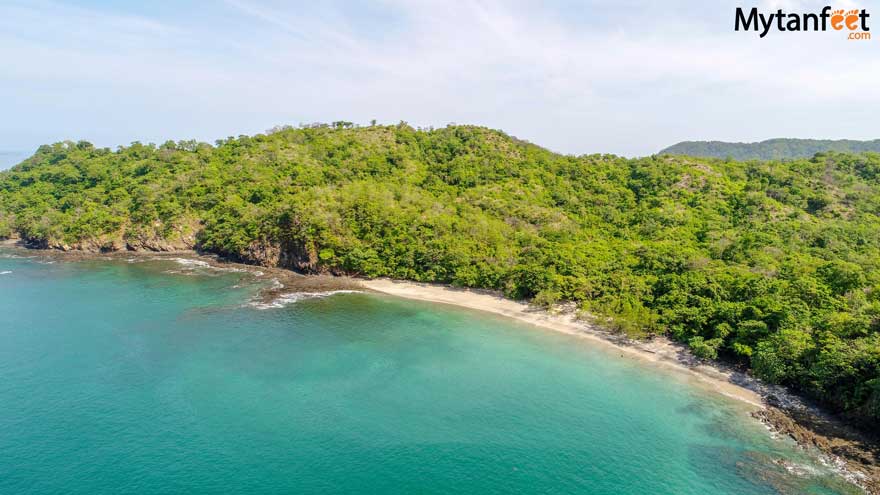
Raininest Months
The rainiest month is October for most of Costa Rica.
Rainy season is what locals call their winter. This also correlates to Costa Rica’s low tourism season. It gets busy in July and August for summer vacation but September, October and November are the lowest tourism season months.
How to prepare for rainy season:
Even though it may be cloudy out, still put on sunscreen. Being so close to the equator means the sun rays are intense even if it’s cloudy.
Bring lots and lots of mosquito repellent. Mosquitoes thrive during rainy season since they breed in stagnant water. Also bring waterproof/water repellent equipment, especially if you have any electronics.
A warm jacket, waterproof jacket and long pants are necessary if you will be anywhere up in the mountains. Read our packing list for rainy season in Costa Rica and our packing list for Costa Rica to be prepared.
Purchase travel insurance! The weather during rainy season can change in a blink of an eye. It can be incredibly sunny one minute and then pouring down rain with lightning the next. Always be prepared when visiting in rainy season to protect your equipment, especially your electronics.
How much does it rain in Costa Rica?
How much it rains in Costa Rica depends on the location. Additionally, El Niño and La Niña both affect Costa Rica.
The important thing to note is that during rainy season, it can rain very hard. If you’ve ever experienced any type of tropical climate, you will know what I’m talking about. You can see in the video below how hard it’s raining in Playas del Coco in October.
Costa Rica Weather Forecast
It is hard to find fully accurate forecast for Costa Rica being a tropical climate. The weather is not always predictable, especially in rainy season.
Weather apps always show thunder and lightning storms everyday in rainy season but it may not be 100% accurate and it doesn’t always mean that it’s raining 100% of the time everyday.
However, there are a couple of sites that can give you a very close prediction such as Wunderground, Windy and the IMN (Instituto Meteorológico Nacional de Costa Rica).
They have stations throughout the country and they post more detailed information for specific places (regional locations).
I like to check Instagram to see what weather is like in Costa Rica at the places I’m going. I look at the hashtag or the location on Instagram to see recent photos posted by other people so I can get an idea of what the weather is like.
Best Activities to Do During Dry Season
Dry season is perfect for those who want to soak in the sun all day long. Beach lovers will love dry season! It’s also great for hiking because you won’t have to worry about getting rained out or going as early as possible to avoid rain.
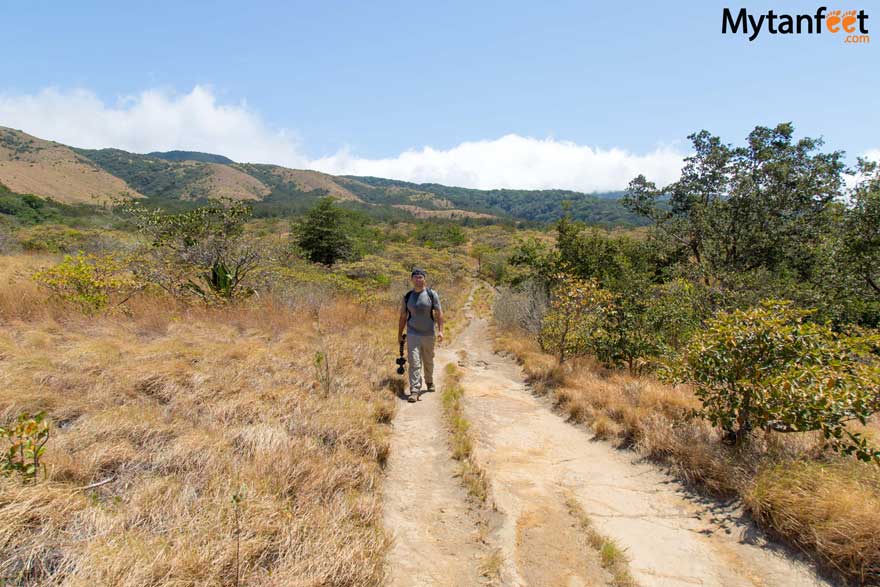
The best activities surfing, hiking, beach hopping, canyoning, boat rides, waterfalls and ziplining. You won’t have to worry about rain at the beach at all.
However, January and February are usually very windy. Due to these winds, the water can get very cold in March, but the cold does bring more wildlife since it stirs up the nutrients.
If you love birds, February – July are excellent months to see the Resplendant Quetzal in Monteverde as it is their mating months. Wildlife watching on rivers is also the best during this time because all of the migratory birds are in Costa Rica.
This is the best time to go to Palo Verde National Park, Rio Tarcoles, Sierpe Mangrove and Rio Tempisque.
Best Activities to Do During Rainy Season
Wildlife watching is best in rainy season. Peak turtle egg laying season is August – December in Tortuguero National Park and Ostional Wildlife Refuge. Peak humpback whale watching season in Costa Rica is August and September.
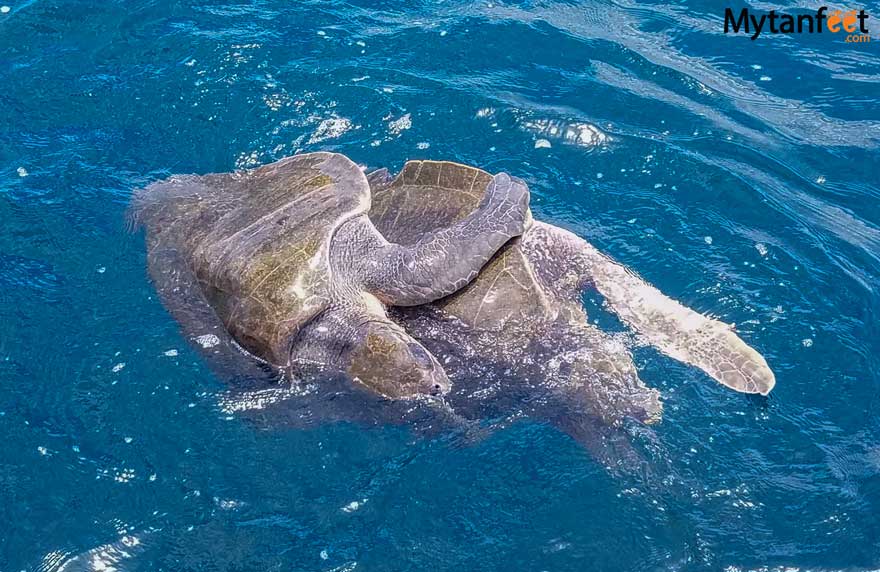
Water activities are also very good. White water rafting is incredible because the water level is high. In dry season, it is normal for rivers to turn into Class 2 and 3 rapids and in rainy season, they turn into Class 3 and 4!
However, if it’s been raining a lot, the rivers and waterfalls may be too full so the tour may have to be canceled, which is one downside.
Tip for activities and tours during rainy season: Schedule activities in the morning. Since average rainy season days are sunny in the morning and rainy in the afternoon, you will have better weather in the morning.
Want to know more about Costa Rica? Check these posts out!
Taking public transportation in Costa Rica
Best places to visit in Costa Rica
Costa Rica Vacation Checklist
- First time to Costa Rica? Read our First Time in Costa Rica guide.
- Not sure how to move around Costa Rica? Read our How to Get Around Costa Rica guide to find the best transportation method for you.
- Click the link to get our detailed Costa Rica Packing List so you know what essential items to bring.
- Do not forget to purchase Travel Insurance for your trip to Costa Rica.
- Stay connected by purchasing a prepaid SIM Card in Costa Rica.
- Save money with Mytanfeet Deals for tours and hotels. Save more money with our Costa Rica Car Rental Discount.

Michele Fisher says
For Canadians out dollar is worth less than half. Use USD for rent and colones for everything else. If all you have is USD change it to colones in a Walmart. That’s called Walmart. You will get the correct exchange. Otherwise if a store takes your USD (not all do) you won’t get any exchange at all.
When in the ocean watch out for RIP TIDES or RIP CURRENTS.
Rip currents are one of the most dangerous and ubiquitous members of Costa Rica’s beach communities. While many factors, including weather, alcohol and misinformation, contribute to ocean-related deaths, the root of most tragedies is rip currents. And no one talks about them. The first year I was here 15 men were taken out to sea because of the rip tides. Read up on them and learn how to spot them and if you get caught in one learn how to survive.
Good luck!
Have Fun!
Lisa Sorenson-Woodhull says
Hi Sammi,
We will be in Manuel Antonia Feb 5 -11. Even though it’s dry season weather forecast says 40 -60% probability rain almost every day. Do you know if it is likely to be brief rain showers, or throughout the day?
Trying to determine how much rain gear to pack.
Thank you!
Sammi says
Hi Lisa, the Central and South Pacific tend to have more rainy weather being the tropical rainforest but as February is the heart of dry season, it’s not likely there will be downpours or anything, I’d throw in a light rainjacket just in case cause you never know.
Delia says
Thank you for this detailed article, definitely pin pointed many of my questions. I am traveling with family in two weeks, and I have seen the forecast reflect a range from 60 to 100% probability of rain. How has it been? Thank you in advance!
Sammi says
Hi Delia, we are in the middle of rainy season so please come prepared for rain
Monica says
Hola Sammi,
My family and I are flying into Liberia on August 4th for our second trip to Costa Rica. We last visited in August 2019 and definitely experienced some rain and a lightning storm on Playa Guiones! We’ve heard it’s been more rainy than usual in July/August and are concerned about being able to surf and enjoy the beaches. Hoping to still have clear sunny mornings! What has your experience been lately? Thanks!!
Sammi says
It is typical rainy season weather this year but with a bit more strong rains at nights
Heather says
Hi! Your blog has been so helpful. We are coming to Tamarindo this Sunday 7/16. Just wondering how the weather has been:)
Thanks
Sammi says
mornings clear and dry, off and on rains
Tom Shoreline says
We are scheduled to travel to the Uvita area Feb 15. We will probably reschedule (deadline to get credit is Jan 15) due to the growing number of people on Tripadvisor testing positive and going through difficult quarantines. Our hotel is small and completely booked so we would need to find another place to stay that will accept a positive test. We realize its a small chance of testing positive but it sounds like the Ministry of Health and US Embassy are overwhelmed and travel to CR may not be wise at this time.
Anna says
Hi! I’ m planning on visiting Costa Rica in early September. I have never been to this country so the goal is to enjoy it as much as possible! What areas would you recommend to visit during this period to avoid the rain as much as possible ?
I plan to visit the region of La Fortuna and Monteverde, Guanacaste and finally the Caribbean coast (from Tortuguero to Puerto Viejo). It seems to me that it is recommended to avoid the South Pacific coast at this period, is it correct ?
Thank you for all the good advice I found on this blog & chat !
Sammi says
Hi Anna, you can check our Best places in Costa Rica for information, just note that the Caribbean Coast is quite far from the Pacific so you’ll need to check into that depending on which airport you fly out of.
Karen Hempler says
Hi,
I have been enjoying your blog and I’m so interested in spending some time in Costa Rica this is to be my second time in the country. This time I wanted to come to the Pacific side of the country I know it is rainy season and so many of the web sites and blogs say that is the time of year to be on Caribbean side is too wet and many places close in Oct. I was reading your a Washingtonian as am I born and raised. The Caribbean side it was nice on my first trip but not what I was hoping for so this trip I wanted to visit the Pacific side. I want to be in a more ecotourism trip,I want the rain-forests, the waterfalls, the beaches, spending time with locals and the wildlife. I have Oct off before my next job starts in Nov. But everything but your blog has tried to turn me off to traveling in Oct on the west-side of the Mt’s..The others only talk about say torrential rains and many places flood so bad you can’t visit and parks close and hotels close. I’m thinking maybe you can let me know is it really that bad and will I have no chance of getting out and enjoying the nature of the area or is there a North, Central, or South part of the Pacific side that is a better visit opportunity in Oct. Let me know what you think
Sammi says
Hi Karen, October is technically our rainiest month and last year in October, we had Tropical Storm Nate. This year’s rainy season has actually been not too bad, usually in Sept by now it’s raining almost each night or at least once during the evening but it’s been pretty dry and hot.
You can still visit in October (and fingers crossed we don’t get another tropical storm) and it’s still very nice. But you do need to be aware of more things like roads getting washed out, national parks closing (Tenorio Volcano in particular) if it’s too rainy, some activities getting canceled if it’s too raining, etc. It’s a bit more work to visit in October because you have to watch out for those things but since you have the whole month off, that’s not bad actually because you’ll have way more time and flexibility to wait and see how the weather is before doing activities. Since most people only have like 1-2 weeks for vacation, they don’t have as much flexibility which is why it’s harder for most people to travel here in October.
On the Pacific coast, it is generally still clear and dry in the mornings and will rain in the late afternoon/evening. That’s a typical rainy season day so you can definitely do a lot of things on the Pacific side. And you’re from Washington so a little rain won’t bother you 😉
I highly recommend coming in October, even though it’s rainier and stay on the coasts. If you go up to the high elevation areas like Monteverde, it’ll be a lot colder and rainier. October is a great time to come because there are way less tourists and even if it does rain a lot, you have the whole month to enjoy. Nature is everywhere so you will be able to experience a lot, especially as it is very green and lush this time of year.
Lesly says
Hi ,
Thanks again for your helpful blog! So I’m going to San Jose first from April 14-18 and then to Jaco April 18-21. What kind of clothing would you recommend ? Are there any tips you have for me regarding my trips ? Thank you!
Sammi says
Hi Lesly, I wrote a packing list post that will help: Costa Rica packing list and here are our articles on San Jose and Jaco: Things to do in San Jose and Jaco Costa Rica.
Lesly says
Thank you so much I read your blog. It says according to your weather blog that is should be humid in San Jose and Jaco. However I checked the weather website you recommended and it said it was going to be raining? Do you think it will be raining?
Thank you!
Sammi says
Hi Lesly, it’s hard to say but the transition period of dry to rainy is coming up very soon (about this time of year and goes until about July). It’s more humid in Jaco but not in San Jose as San Jose is around 1200 meters in elevation so it’s a lot fresher there. But it could rain in San Jose, it’s common for it to rain at the end of April signaling the transition to rainy season. It’s really difficult to predict weather here because it’s tropical weather and climate change has affected the weather here greatly. Last year we had a crazy intense rainy season with a tropical storm so if this year is like last year, I would expect to run into some rain at the end of April. The best advice I can give for weather forecasts is to use that site and then check Instagram. Look at the location tags on IG and you can see pictures people post in real time and ask them how the weather has been like.
Lesly says
Thank you so much !!
Christine says
Planning a honeymoon June 2019 in Costa Rica! Want to explore and do some deep sea fishing. Would you recommend the North or Central Pacific areas?
Cheryl says
Hi! We’re thinking of doing the same 8-day tour in Costa Rica from Costa Rica Monkey Tours through Groupon Getaways. Do you know of any issues with the Groupon vouchers? Also, I watched the entire video of your trip, looks like so much fun!!! What time of the year was that? I would prefer a dry season.
Thanks for any info & awesome posts & videos!
Cheryl
Sammi says
Hi Cheryl, we did the tour in March so we had great weather everywhere we went. I haven’t heard any issue with Groupon and if you have any questions, you can call the Costa Rica Monkey Tours people directly and ask them, they have a hotline and online chat. Enjoy!
Lee says
Hi 🙂 second week of Month of May what kind of weather could we expect in the Samara area of CR?
Sammi says
Tropical weather is always unpredictable so I can’t say for sure what it’ll be like, but it should start getting cloudier and might have some random short showers. Still super hot, but will get humid with the short rains.
Ruben says
I’ll be arriving in Playas Del Coco on Nov 24, which is just the tail end of rainy season according to what I’ve been reading on your very informative site. Am I going to experience more sun than rain? I’ll prepare for both, but from reading that you used to live there, what’s your experience during that time of the month?
Kind regards!
Sammi says
Hi Ruben, at the end of November you may run into some rain but not too much. In Coco it has a fairly short rainy season so it’s usually very beautiful and sunny in the morning and rains in the afternoon.
Sammi says
Hi Daniela, I recommend reading this post to be prepared for rainy season: Rainy season packing list Costa Rica
When it comes to your camera and electronics, you gotta get a 100% waterproof backpack or a rain cover for the bag. And a rain jacket, and plenty of plastic bags. It’s the only way to really protect your stuff against the sudden rainstorms in Costa Rica. You have to be prepared!
Daniela says
Hi! We’ll be there on Thursday! Hopefully we’ll get nice and rainy climate.
I’m afraid for my camera and electronic stuff. We’ll be able to enjot Santa Teresa beach and Playa Palo Seco.
Do you think it’s a good idea?
We’ll be there for 10 days and still don’t have Tours for the National Parks 🙁
Amina says
Hello! Sorry another question about the unpredictable weather! We are coming to playa Hermosa next week…ill pack my rain gear for sure. Will there be some sunshine too do you think based on how it’s been in May time before? Thanks!
Sammi says
Hi Amina, it’s always sunny in Costa Rica, particularly in Guanacaste but it may rain here and there in May. In May it’s still transitioning to rainy season in Guanacaste so you may get some random periods of rain (20, 30 min) but it’s always very sunny and hot.
Sammi says
You can – August does see rain but it is generally hot and sunny in the mornings and rains in the late afternoon/evenings. Just make sure you go early in the morning and pack properly in case it rains. Here is our tips for packing in rainy season post: Rainy season packing list Costa Rica
The Flamingo beach resort is right on the beach too so if it starts to rain you don’t have far to run inside.
Johan says
Good to know you right is a short run to the hotel lol thanks for the info
Johan says
Hi guys,
I’m going at the end of August and I know is raining season and the weather is hard to predict but I wanted to know if I would be able to enjoy the beaches a bit during this month? Or basically I’ll have to stick to other indoor activities ? I’m staying at flamingo beach resort for a week so hopefully I’ll get some dry days
Frank says
Yes, I remember the regional differences when we went. Rained non-stop at Arenal, but we very dry along the coast in Santa Teresa.
The other thing I’ll never forget were the winds in the Central Valley. Flew a small plane in to San Jose from the coast and it was the scariest flight we’ve ever had!
Frank (bbqboy)